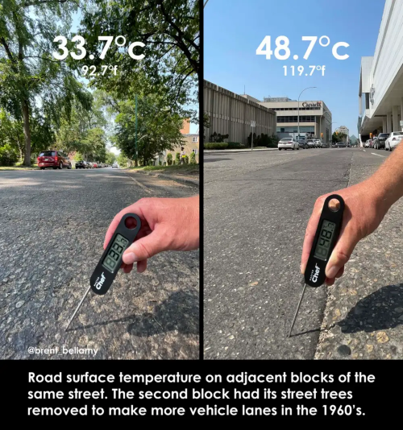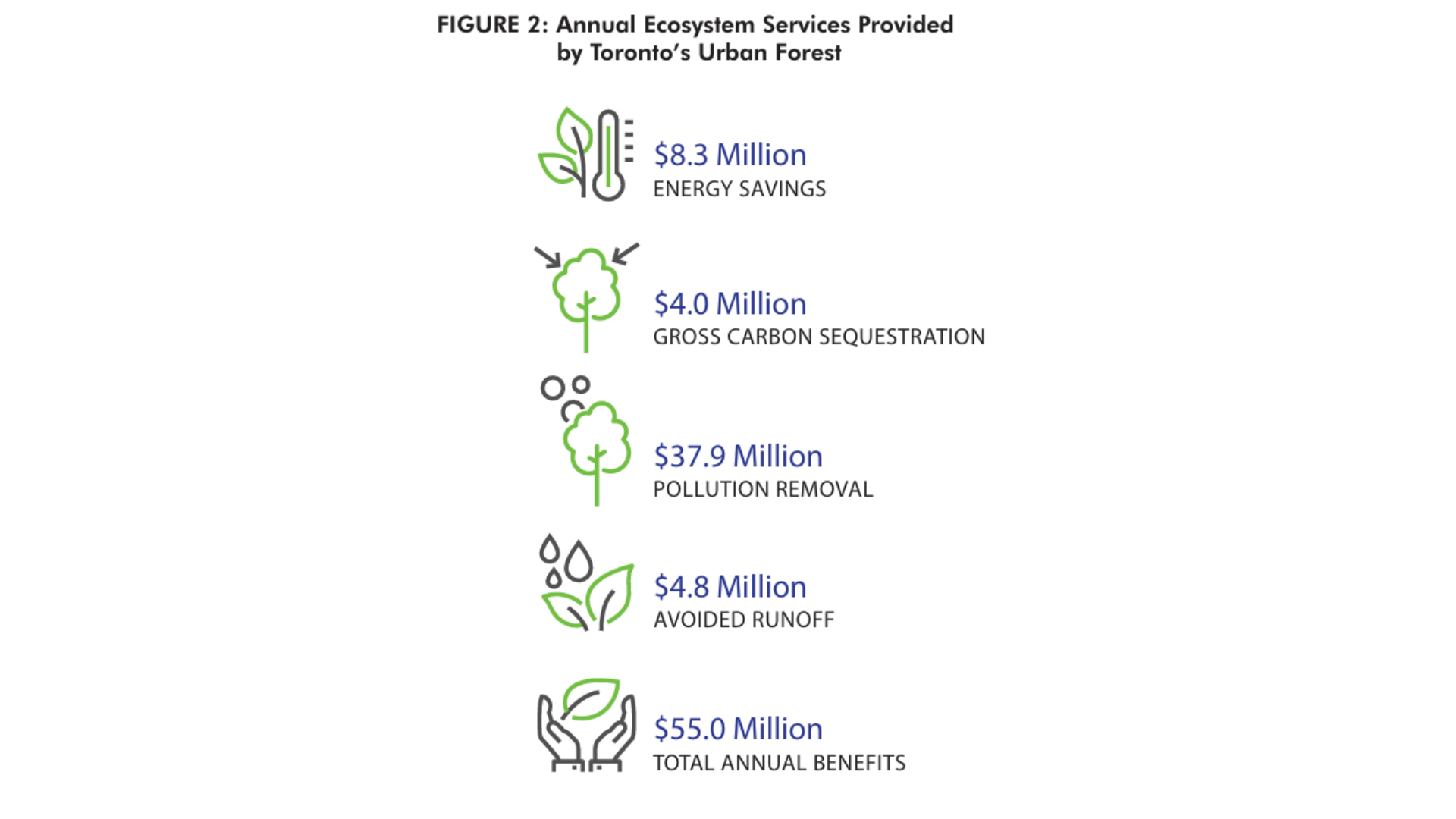As we explored in the first blog of this two part series, Toronto is facing increasing challenges due to rising temperatures caused by climate change and fueled by burning fossil fuels like oil, gas, and coal.
As temperatures rise and the city continues to grow, the importance of tree canopies and tree canopy equity becomes more crucial. These natural “urban forests” not only enhance the aesthetic appeal of urban spaces but also play a vital role in mitigating heat stress, improving air quality, and promoting overall well-being.
Imagine a boardwalk with no trees versus a street lined with old oaks. The tree-covered street stays cooler and feels more inviting, offering shade and a peaceful atmosphere. In contrast, a boardwalk without trees is hotter and lacks the natural beauty and comfort that trees provide.
Understanding Tree Canopies
Tree canopies are the layers of leaves, branches, and stems of trees that cover the ground when viewed from above. This green umbrella provides a range of ecological, social, and economic benefits, including:
- Reducing Air Pollution and Providing Oxygen: Trees absorb pollutants and release oxygen, improving the air quality we breathe.
- Cooling the City: Tree canopies can significantly lower urban temperatures, reducing the need for air conditioning and conserving energy.

- Water Management: Trees improve water filtration, store water, and reduce storm water runoff, helping to manage urban water systems.
- Supporting Wildlife: They provide habitats for various species, enhancing biodiversity.
- Ecosystem Services: Services provided include carbon sequestration, pollution removal, energy savings and avoided runoff, worth an estimated $55 million annually.

Beyond the environment, there are many socio-economic benefits with the use of tree canopies as well. According to the Government of Canada, increased tree cover is associated with:
- Reduced mortality rates
- Lower levels of obesity
- Improved mental health, including decreased feelings of depression and anxiety
The Need for Tree Canopy Equity
Did you know, as of 2018 Toronto’s tree coverage is 28.4%? The city’s goal is to increase the canopy to 40% by 2050 so more communities can enjoy the benefits of the urban forest.
Tree canopy equity is about fair access to the benefits trees provide across all neighborhoods. In many cities, including Toronto, disparities exist in the distribution of green spaces, with marginalized and low-income communities often having less access to green spaces and the associated health and environmental benefits.
A useful guideline for assessing whether an urban area has sufficient trees is the 3-30-300 rule outlined below.
Taking the 3-30-300 rule:
- Everyone should be able to see at least 3 trees from their home.
- Communities should ensure a 30% tree canopy in all neighborhoods.
- All residents should have a greenspace of at least one hectare within 300 meters of where they’re living.

How is the City tackling the problem?
Toronto has recognized the importance of tree canopies and is actively working to enhance tree cover and promote equity across the city. Some initiatives include:
- The Toronto Urban Forestry Plan: The City of Toronto is committed to reaching a 40% tree canopy coverage by 2050. They have said they will take an equity approach to prioritize canopy growth at the neighbourhood scale.
- The Neighbourwoods Program: A community-based program involving local residents in the care and maintenance of trees, fostering a sense of ownership and responsibility for urban green spaces.
- The Tree For Me Program: An initiative providing free trees to residents and community groups, encouraging them to plant and care for trees in their neighborhoods. It aims to increase tree canopy cover in underserved areas.
Tree canopies are essential for creating a healthy, resilient, and inclusive urban environment. As Toronto continues to grow and face the challenges of heat stress and climate change, investing in these green assets will be crucial.
By prioritizing tree planting and maintenance in underserved communities, Toronto can create a city where every resident enjoys the numerous benefits of a thriving urban forest.
How can you get involved?
- Volunteer for Tree Planting: Join community initiatives to plant and care for trees in your neighborhood. Examples of tree planting community initiatives are: YourLeaf, Forests Ontario Tree Planting Initiative, Tree Canada, City of Toronto, along with many more.
- Advocate for Green Spaces: Support policies that promote tree canopy growth and maintenance.
- Educate and Raise Awareness: Raise awareness of the importance of trees to the natural environment and the need to manage resources sensitively. Check out this tool to see your neighborhood’s tree equity score!

